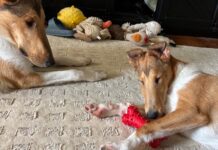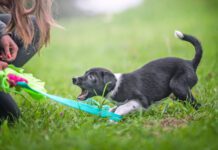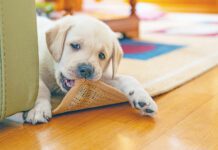It never ceases to amaze me just how much stuff puppies can get into in even the most thoroughly puppy-proofed environments. Take your eyes off of a young dog for a moment, and she’ll have found the screw to the dishwasher that went missing six months before she arrived (ask me how I know…). Even after several decades of cohabitating with canines, every time I bring a new dog home, I learn something about how to better puppy proof my house.
First, it’s worth noting that puppy proofing is something of a moving target. Your puppy’s interests and ability to reach things will change as he grows. Ideally, you’ll also be balancing out his trouble-finding tendencies by teaching him good house manners, providing him with acceptable things to chew on, and training cues such as ‘leave it’.
How to Puppy Proof Your House
Keeping your puppy safe—and household destruction to a minimum—starts before the puppy joins the family. Prior to his arrival, you will need to take a close look at the areas of your house your puppy will have access to and remove as many potential problems as possible. When assessing a space for puppy-friendliness, I often sit or lay down on the floor to better spot anything that might appear interesting from a dog’s eye level. Among the things I watch for are:
- Electrical cords and outlets: Beyond the obvious potential for electrocution, puppies can pull heavy objects—such as the television—down on themselves by tugging on electrical cords. Get outlet covers to protect any unused outlets from moist puppy noses and tie up or cover cords. You’ll also want to keep the puppy away from rooms where cords can’t be adequately protected.
- Plants: Many common household plants are poisonous to dogs. Even for the varieties that aren’t toxic, puppy teeth can make short work of a houseplant. It’s best to make sure any indoor plants are out of reach and that any dead leaves won’t fall somewhere the puppy can get to them.
- Cleaning products and other chemicals: Household cleaning products are often toxic to dogs. Make sure cleaners and other chemicals are out of reach—preferably in a drawer, cabinet, or closeable container the puppy won’t have access to. It’s rare, but some puppies do teach themselves how to open cabinet doors (I’ve had one.). If you see your puppy pawing at or mouthing doorknobs, it may be time to install child safety locks on cabinet doors and drawers.
- Shoes and clothing: Is there anything more iconic than a puppy chewing a shoe? Sadly, there’s more than an ounce of reality in that image. Make sure shoes—along with socks, hats, and any other loose clothing—are kept out of reach of curious puppies.
- Stairs: Like human toddlers, puppies take awhile to develop the coordination and strength necessary for safely going up and down stairs. Ensure the puppy doesn’t have access to stairs until he and you are ready. Baby gates are an inexpensive and useful tool for keeping young dogs away from stairs and out of rooms that might not be safe for them.
- Wicker, wood, and furniture: While it’s rarely worth moving the furniture around when puppy proofing, ask yourself if there are any pieces you will be upset about having teeth marks in. Move those to somewhere the puppy won’t have access to or don’t let the puppy in the same room without supervision. I’ve also found that anything made of wicker can be particularly appealing to puppies.
- Toys and small objects: Children’s toys, knickknacks, and other small objects can be choking hazards for puppies or, if swallowed, may lead to potentially deadly intestinal blockages. Anything that falls into this category should be removed from areas where your puppy will be spending time.
- Food: If it is food—or might be mistaken for food—chances are good that your puppy will try to eat it. Store dry goods out of reach and make sure pantry and cupboard doors shut firmly. If necessary, invest in child safety locks.
- Trashcans: Trashcans are often a source of exciting, smelly, off-limits things. Don’t fool yourself into believing that a trashcan with a lid is the answer. Many determined puppies develop strategies for opening lids—or knocking over bins—to get what they want. Invest in a trashcan with a locking lid or move trashcans to a spot the puppy can’t get to.
- Books: I’ve had several puppies who liked to take books off of bookshelves for use as chew toys. If your puppy shows an inclination toward exploring shelves, you may need to clear off any shelf he can reach, revoke his access to rooms with a lot of stuff on the shelves until he is more mature and better trained, or cover lower shelves with something like plywood so he can’t get to them.
- Valuables: Like kids’ toys, small items with interesting textures, such as jewelry and eyeglasses, are a favorite for many puppies. That goes double if it is something you wear regularly enough that it smells like you. Make sure these things are stored somewhere out of reach and start reminding yourself early not to casually set your glasses down on the coffee table.
Other Considerations
I have learned the hard way that “high up” doesn’t necessarily mean “safe from the puppy.” When it comes to things on countertops, assume your puppy will attempt to investigate any surface he can reach. During a growth spurt, especially for a large breed youngster, that level can get higher quickly. Some puppies, even very young, very tiny ones, can climb quite high if the idea strikes them. Keep a close eye to see if you need to clear the countertops of anything dangerous or important to you (keys, coins, jewelry, paperwork, etc.).
Once you are done securing all of the spaces your puppy will have access to, ask yourself what might happen if he slips past someone and gets into a room where he’s not allowed. Is there anything immediately hazardous—such as chemicals—that he could grab before you can get to him? Also, is there anything of value that he might damage in a burst of puppy enthusiasm at finding a new place to play? It’s best to assume the worst and do some basic puppy proofing even in rooms you aren’t planning on letting him visit until he’s had some training.
While separate from puppy proofing, there are two things I do with my new puppies that go a long way toward keeping them safe in the house until they’re well-trained enough to be trustworthy. The first is crate training. Teaching a puppy to be comfortable in a crate means there is always a safe spot she can go when I can’t keep both eyes on her. Second, I often use a leash or tether to keep my new puppies close to me. This gives the puppy some freedom but doesn’t let her get so far away that I can’t see what she’s doing.
For more tips on how to prepare for a new puppy, see “What to Know as a First Time Dog Owner.”
When you are in the process of puppy proofing your house, don’t forget about the yard. While you should always supervise young puppies outside, it’s important to do a thorough check of any outdoor area they will have access to in order to make sure it’s safe. Things to remove include:
- Poisonous plants
- Chemicals (including pesticides/herbicides used in lawn care)
- Swallow-able rocks, sticks, and other small items
- Gaps in fencing
- Insect nests (hornets, bees, ants, etc.)
- Standing water
- Access to swimming pools







Great article!
I am currently raising a 5 mo. old Pit Bull puppy.
I had or got several ex-pens (24 ” tall), I put one around and tie wrapped to the table where my computer sits, with all the wires/power cords hanging down. It looks pretty weird, but he hasn’t managed to get near any of those wires.
Another is in front of a bookcase in the hall, so he can’t get to the books.
I live alone, so the suggestions about toys don’t apply.
I routinely put my (leather) shoes up on a bar-height counter.
It’s only for another year…
Kitti